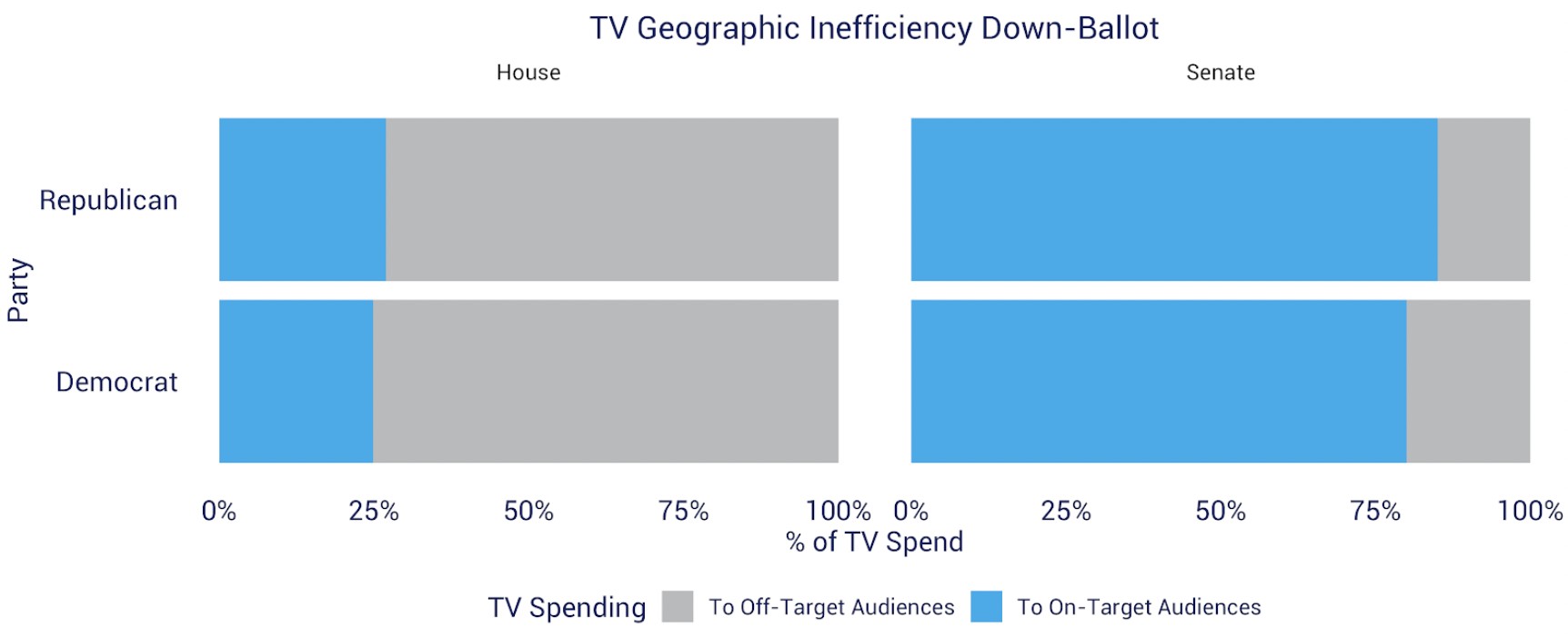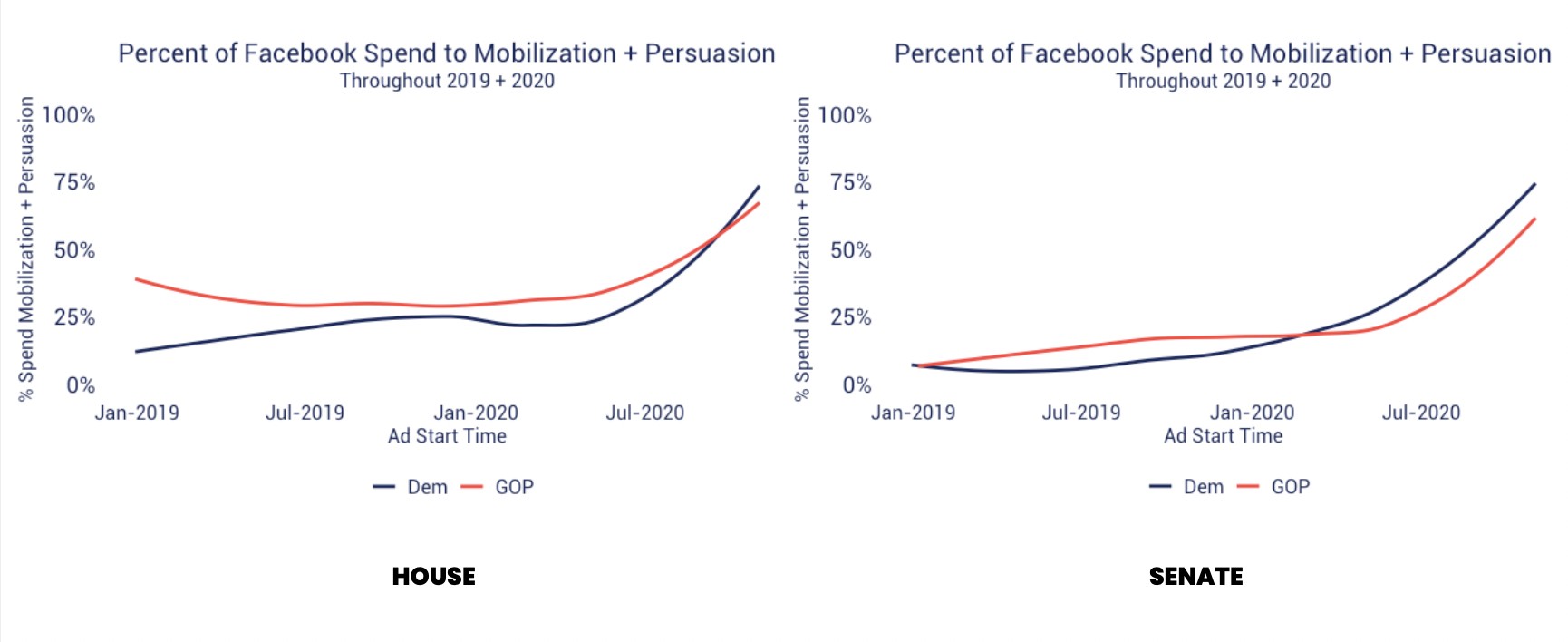Memo: How Democrats Can Optimize Media Spending And Stop Wasting Millions
TO: Interested Parties
FROM: Priorities USA
DATE: April 13, 2021
RE: How Democrats Can Optimize Media Spending And Stop Wasting Millions
Following the 2020 election, Priorities USA conducted an extensive analysis of $5.4 billion in Democratic and Republican ad spending in federal elections by both campaigns and outside groups. The findings provide important lessons for Democrats running future campaigns, especially the 2022 midterms. While Democrats outspent Republicans in 2020, we are not spending smart enough to maximize our chances of winning elections moving forward. Millions of dollars were spent in the final weeks of the campaign on inefficient TV buys that were talking to people who had already voted. Making matters worse, 75% of these TV ads in House races were aired outside of the district that they were intending to target. Meanwhile, too little is spent on mobilizing voters, especially down ballot. Each of these problems leaves votes on the table and will make the difference between keeping or losing our majorities in both chambers of Congress in 2022.
Democrats Are Spending More Than Republicans, But Not Necessarily Smarter
Democrats did spend more than Republicans at every level of federal campaigns during the 2020 cycle – including online, which shows remarkable improvement from the 2016 cycle – but the ad spending has a lot of room to become smarter.

Media consumption research shows that Americans are spending a rapidly increasing share of their time on digital, rather than traditional media. While this shift has been occurring for quite some time, the pace of change has been accelerating in recent years. This means that the media landscape in one election is very different from the next and advertising strategies must adapt to incorporate those changes.
Unfortunately, political ad spending failed to fully take these changes into account in 2020. While the presidential campaigns increased their share of digital spend, down ballot saw low digital spending compared to traditional media spend. eMarketer found that in 2020, Americans spent about 5.75 hours per day with traditional media and nearly 8 hours per day with digital media. Despite that, Democrats invested 77% of their spending on traditional media.
Priorities USA has put an emphasis on increasing digital as a share of the media mix, with a 50-50 split between digital and TV during the 2020 cycle.

TV Is Increasingly Inefficient, Especially Down Ballot
Traditionally, campaigns have put an emphasis on late TV and then worked their way back down the advertising priority list. Most campaign managers and media consultants obsessively watch the TV competitive to ensure they are matching points in the final weeks of the campaign. The need to match the 6,000th point on TV during the final week or two of the campaign is typically prioritized over earlier digital persuasion or mobilization spending. This needs to change. It is of course true that late money will continue to be a factor in campaigns, but if we took just 1% of the late spending and invested it in additional organizing infrastructure on the ground, we could generate an immensely higher longer-term return on investment.
Priorities’ analysis of down-ballot 2020 ad spending found that particularly in House races, TV is now wildly inefficient with roughly 75% of the spending reaching voters outside of the targeted district. The problem is significantly decreased in Senate races.

The reason for TV becoming an increasingly inefficient form of communication in House races is quite intuitive. The current House battleground has shifted to focus primarily on suburban and exurban districts. This means the districts are typically in larger media markets and make up a much smaller share of the DMA than a decade ago when more rural districts that made up entire media markets were in play.
Conversely, non-fundraising or list-building digital spending was almost entirely directed at the on-target audience, making it a far more efficient form of communication in districts that make up only a portion of a DMA.

Spending Is Also Ramping Up Too Late
The type of media was not the only factor in whether or not ad dollars were being wasted by Democrats in 2020. The timing was also important. Due in part to the cyclical nature of political fundraising as well as fears of decay in advertising effectiveness, Democrats continued to wait until close to Election Day to dramatically ramp up ad spending.

This late spending failed to fully account for the unprecedented nature of the 2020 election and the immense increase in early voting and vote-by-mail. The results of this failure to adapt were dramatic. Priorities’ analysis found that 10% of Democrats’ total ad budget likely went to communicate with voters who had already cast their ballot in 2020. Democrats can remedy these spending inefficiencies by investing earlier in the campaign cycle — getting their message out to more voters before they head to the polls. Early investments in a multi-channel media strategy will allow candidates and organizations to more effectively persuade voters with longer, sustained outreach campaigns. Late money ought to be focused on more targeted mechanisms. In a cycle where Democratic campaigns and outside groups spent roughly $3.1 billion on ads, that means roughly $334 million was wasted on people who had made up their mind and cast their ballot.
Again, it is important to emphasize this isn’t necessarily about spending more money. Rather it is about when campaigns and organizations receive contributions, the type and timing of media spend, and the need for early investment in organizing.
Recommendations
If Democrats want to continue to win close elections, it is imperative that we adapt investment and ad spending strategies to the changing electoral battleground, media consumption habits, and voting trends.
-
Invest early. One of the biggest challenges for campaigns, party committees, and allied organizations is the timing of donor contributions at every level of giving. Of course late giving is helpful but it also incentivizes inefficient spending, particularly on television. Earlier investments will allow candidates and organizations to make smarter investments, especially in terms of building organization infrastructure and long-term digital communication.
Early investments in allied organizations allow them to invest in the infrastructure needed to support effective field, get-out-the-vote, digital organizing, and digital communication campaigns. In short, early investments will help campaigns and organizations run smarter, more strategic, and better managed campaigns.
-
Campaigns and organizations need to adjust spending to reflect changing voting patterns due to vote-by-mail, drop boxes, and early voting. We must all do a better job of minimizing the money spent on voters who have already cast their ballot. Strategies should be flexible to reflect the changing legislative and legal landscape around voting rights.
-
TV advertising is an important part of any competitive federal campaign, but as TV becomes increasingly more inefficient, the media mix must include more digital, especially in multi-district media markets.
While this is true at every level of the ballot, it is particularly pronounced at the House level where an unwillingness to spend more on non-fundraising or list-building digital communication leads to immense waste. With a slim House majority, it is imperative that ad spending decisions evolve and modernize to recognize the reality of the House battleground and calendar.
-
Paid communication must include effective strategies for mobilization and persuasion, particularly in a midterm election when a presidential campaign is not investing millions in get-out-the vote operations. This includes more coordinated, wider reaching early vote communication, particularly online.